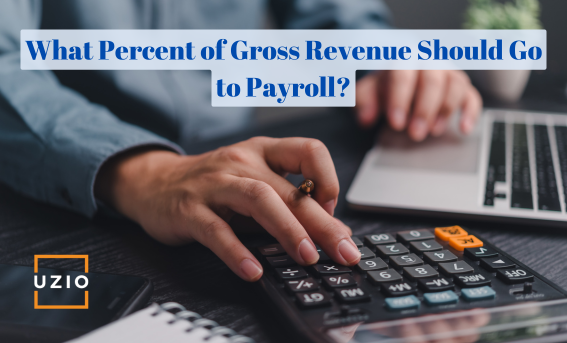
How Much of Your Gross Revenue Should Go to Payroll? A Practical Guide
Quick links
-
What is Payroll as a Percentage of Revenue?
-
How to Calculate Payroll to Revenue Ratio
-
What is a Good Payroll Percentage?
-
Interpreting Your Payroll to Revenue Ratio
-
Strategies to Reduce Payroll Percentage
-
Automation and Workforce Management to Optimize Payroll
-
Conclusion: Finding the Right Balance
1. What is Payroll as a Percentage of Revenue?
Payroll as a percentage of revenue refers to the proportion of a company’s gross revenue that is allocated toward employee wages, benefits, and taxes. This figure is a critical metric for understanding how much of a business’s income is directed toward compensating its workforce.
For businesses of all sizes, managing payroll costs is essential to maintaining a healthy budget. By calculating payroll as a percentage of revenue, companies can determine whether they are spending too much or too little on labor in comparison to their earnings.
In practice, this metric helps business owners and financial managers make informed decisions about hiring, raises, and managing other operational expenses. When payroll costs are too high, it can squeeze profit margins and limit growth potential. On the other hand, too low a payroll percentage may indicate under-investment in employees, potentially leading to reduced productivity or lower employee satisfaction.
In summary, payroll as a percentage of revenue is a valuable indicator of business health and a key tool for balancing labor costs with overall financial performance. It allows companies to measure their efficiency and adapt their payroll strategies in alignment with their revenue.
2. How to Calculate Payroll to Revenue Ratio
Calculating the payroll to revenue ratio is a straightforward process that gives you a clear picture of how much of your business’s income is spent on compensating employees. This ratio is a vital tool for monitoring the financial health of your business and ensuring that payroll costs are aligned with revenue generation.
Calculate Payroll to Revenue Ratio:
- Determine Total Payroll Costs: Include all direct labor expenses, such as employee wages, salaries, benefits, payroll taxes, and any other compensation-related costs.
- Identify Your Gross Revenue: Gross revenue refers to the total amount of income generated from your business’s operations before any expenses, including payroll, are deducted.
- Apply the Formula: Use this simple formula to calculate your payroll to revenue ratio:
Payroll to Revenue Ratio=(Total Payroll Costs/Gross Revenue)×100
Example Calculation
If your total payroll costs are $500,000 and your gross revenue is $2,000,000, the payroll to revenue ratio would be:
(500,000/2,000,000)×100=25%
This means that 25% of your revenue is going toward payroll.
Why It’s Important:
Calculating the payroll to revenue ratio regularly allows you to track trends over time and compare your business’s performance against industry benchmarks. If the ratio is too high, it could signal that payroll costs are consuming too much of your revenue, potentially reducing profitability. Conversely, if the ratio is too low, it may indicate underinvestment in your workforce, which could hinder growth or productivity.
In conclusion, the payroll to revenue ratio is a valuable tool for optimizing payroll expenses and ensuring that your business is running efficiently while maintaining a healthy balance between labor costs and revenue.
3. What is a Good Payroll Percentage?
Determining a good payroll percentage is essential for maintaining financial stability and ensuring your business runs efficiently. However, there is no one-size-fits-all answer, as the ideal payroll percentage varies widely depending on the industry, company size, and business model.
Industry Benchmarks for Payroll Percentage:
- Service Industry: Businesses in the service sector, such as restaurants, retail, and hospitality, often have higher payroll percentages, typically ranging between 25% to 40% of gross revenue. These industries rely heavily on labor to deliver services, making labor costs a significant portion of their expenses.
- Manufacturing: Companies in manufacturing usually have lower payroll percentages, often between 15% and 30%. This is because many manufacturing businesses rely on automation and capital investments in equipment, reducing the relative burden of labor costs.
- Tech and Software: In tech-focused industries, the payroll percentage can vary greatly, but it tends to be between 20% and 35%. High-skilled labor, such as software engineers and developers, can command higher wages, but these businesses often have strong revenue streams that can support this payroll investment.
Factors Influencing a Good Payroll Percentage:
- Business Size: Smaller businesses may have higher payroll percentages in the early stages as they invest in talent to drive growth. As the company scales, revenue increases, which typically reduces the payroll percentage.
- Growth Stage: Businesses in growth phases may experience higher payroll percentages as they expand their teams to support new operations or markets. During these stages, it’s crucial to monitor payroll closely to ensure it doesn’t outpace revenue growth.
- Labor-Intensive vs. Capital-Intensive Industries: Businesses in labor-intensive sectors, such as construction, healthcare, or education, will naturally have higher payroll percentages compared to capital-intensive industries that rely more on machinery or technology.
General Rule of Thumb:
While the ideal payroll percentage depends on your specific industry and business model, a common guideline for many businesses is to keep payroll costs between 15% and 30% of gross revenue. This range allows enough room for profitability while still ensuring you are investing adequately in your workforce.
In summary, a good payroll percentage should align with industry standards, support your business’s growth goals, and be monitored regularly to adapt to any changes in revenue or operational needs. Keeping payroll expenses in check ensures that your business remains competitive and sustainable in the long run.
4. Interpreting Your Payroll to Revenue Ratio
Once you’ve calculated your payroll to revenue ratio, the next step is understanding its impact on your business for better staffing, budgeting, and financial decisions.
What Does It Tell You?
- High Ratio (above 40%): Signals high labor costs, potential inefficiencies, or overstaffing, which could hurt profitability during slow growth.
- Low Ratio (below 15%): May indicate underinvestment in staff, risking employee burnout or low productivity. It could also suggest heavy automation or outsourcing.
- Balanced Ratio (15-30%): Reflects effective labor cost management, allowing sustainable growth and competitive compensation.
How to Use It:
- Hiring: A high ratio may suggest pausing hires, while a low ratio could mean expanding your team.
- Compensation: A low ratio might require boosting pay to stay competitive, while a high ratio could call for adjusting bonuses or overtime.
- Productivity: A high ratio without revenue growth may signal inefficiencies; consider investing in training or automation.
- Industry Comparisons: Regularly benchmark your ratio against industry standards to stay competitive.
Interpreting this ratio helps assess labor costs and overall business health. Regular monitoring ensures informed decision-making and long-term sustainability.
Recommended Reading: Transforming HR Efficiency: The Power of AI in Document Processing
5. Strategies to Reduce Payroll Percentage
Reducing payroll costs doesn’t have to mean cutting staff or wages—it’s about optimizing processes and managing labor efficiently. Here are some strategies to lower your payroll percentage:
- Leverage Automation: Automate routine tasks (e.g., payroll, customer service) to reduce labor hours and increase efficiency.
- Improve Workforce Management: Use smart scheduling tools to match staffing to demand, avoiding overstaffing during slow periods.
- Outsource Non-Core Functions: Outsource tasks like IT or HR to cut full-time employee costs while accessing specialized services.
- Utilize Part-Time or Contract Labor: Hire part-time or contract workers for specific tasks, reducing the overhead of full-time employment.
- Optimize Employee Productivity: Invest in training and technology to boost productivity, allowing fewer labor hours to achieve the same results.
- Review Overtime Policies: Cap or redistribute overtime to control costs, or hire part-time staff to handle peak periods.
- Consider Employee Incentive Programs: Implement performance-based bonuses or profit-sharing instead of across-the-board raises.
- Reevaluate Compensation Packages: Ensure wages and benefits are competitive but sustainable, possibly restructuring benefits or offering flexible work options.
Reducing payroll percentage is about smarter labor management. By leveraging automation, outsourcing, and optimizing workforce practices, you can lower costs while maintaining employee satisfaction and productivity.
6. Automation and Workforce Management to Optimize Payroll
Using automation and better workforce management can reduce payroll costs while boosting efficiency and maintaining employee morale. Here’s how these strategies can help:
-
Automation in Payroll and HR
- Payroll Processing: Automating payroll reduces errors, saves time, and ensures compliance.
- Time Tracking: Automated systems monitor hours accurately, preventing time theft.
- Onboarding/Offboarding: Automating these processes reduces administrative tasks and ensures compliance.
-
Workforce Management for Scheduling
- Dynamic Scheduling: Tools adjust staffing based on demand, avoiding overstaffing and reducing overtime.
- Predictive Analytics: Forecasts labor needs, enabling real-time adjustments.
-
Performance Management
- Employee Tracking: Automated tools monitor productivity, rewarding high performers and addressing underperformance.
- Flexible Work: Remote or compressed work arrangements can cut payroll costs and office overhead.
-
Use of Part-Time/Temporary Workers
- On-Demand Labor: Automated scheduling helps hire part-time or contract workers for specific needs, avoiding long-term costs.
-
Real-Time Payroll Data
- Insights: Automated payroll provides real-time metrics on labor costs, enabling better decision-making.
Automation and workforce management strategies help cut payroll costs, improve efficiency, and keep employees satisfied. This results in a more cost-effective and agile payroll system that supports growth.
7. Conclusion: Finding the Right Balance
Understanding and managing your payroll as a percentage of revenue is crucial for the long-term success and financial health of your business. Striking the right balance between labor costs and revenue generation ensures that your company remains profitable, competitive, and able to grow sustainably.
Key Takeaways:
- Monitoring Payroll to Revenue Ratio: Regularly calculate and monitor your payroll to revenue ratio to understand how much of your revenue is being allocated to labor costs. This simple metric gives you insights into whether your payroll expenses are aligned with your business goals and industry standards.
- Adapting to Industry Benchmarks: Different industries have varying payroll benchmarks, so it’s important to compare your business’s payroll percentage with that of similar companies in your sector. This helps you avoid overpaying for labor while ensuring your workforce is adequately compensated.
- Optimizing Payroll Costs: By using strategies such as automation, workforce management tools, and outsourcing, you can reduce unnecessary payroll costs and improve overall operational efficiency. These techniques allow you to maintain a productive workforce without inflating labor costs.
- Investing in Your Workforce: While managing payroll is essential, underinvesting in your employees can hurt productivity and hinder business growth. It’s important to strike a balance between controlling labor costs and ensuring that your team remains motivated, engaged, and adequately compensated.
Final Thoughts:
Your payroll to revenue ratio is more than just a number—it’s a key indicator of your business’s efficiency and financial health. By continuously evaluating and optimizing this ratio, you can make informed decisions about hiring, compensation, and workforce management. Ultimately, the goal is to ensure that labor costs support your business’s growth and profitability without straining your financial resources. Regularly reviewing your payroll percentage and adapting your strategies will help your business thrive in the long run.
To know more about UZIO Payroll/HR solution for the cannabis industry and get in touch with us for an expert-led demo.





